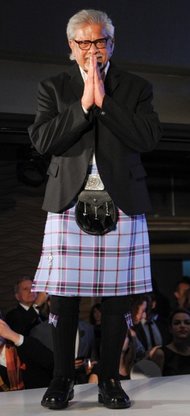 Source: Catalyst House: Our friend and associate, M.K. Gandhi grandson Arun Gandhi, may seem odd as a runway model, but he recently strutted the runway wearing a kilt and ‘Peace Tartan’ for charity.
Source: Catalyst House: Our friend and associate, M.K. Gandhi grandson Arun Gandhi, may seem odd as a runway model, but he recently strutted the runway wearing a kilt and ‘Peace Tartan’ for charity.
Arun was born in the apartheid South Africa. During his early teen years he lived with his Grandfather in India where he received one-on-one daily instruction from ‘Mahatma’ Gandhi on understanding violence, its causes and nature and the opposite living philosophy of nonviolence.
Following in the footsteps of his grandfather, Arun is a true social activist who transverses the planet regularly, lecturing on nonviolence and introduces himself as a “Peace Farmer.”
Arun founded and stewards the Gandhi Worldwide Education Institute, which champions against child labor and poverty and rescues Indian children from human traffickers. (disclosure: I am am honored to be a Board member of that organization).

Source: NY Times India Ink Blog –
On Monday, Mr. Gandhi donned a World Peace tartan kilt designed by Victor Spence, a Scotsman who has created a line of tartan clothes and accessories to promote world peace at the “From Scotland With Love” fashion show at Stage 48 on the West Side. The annual charity event was started 11 years ago by the actor Sir Sean Connery and the Scottish businessman Geoffrey Scott Carroll to promote Scottish culture in the United States. This year’s theme, “The Scottish Lion Meets the Asian Dragon,” included a mix of Asian and Scottish clothing from designers around the world. Proceeds will benefit the Wounded Warrior Project, a nonprofit group that helps injured American soldiers when they return home from war in Iraq and Afghanistan.
Mr. Gandhi was joined on the runway by the host of ABC’s “Good Morning America,” Josh Elliott, and Lt. Colonel Martha McSally, who is the first female fighter pilot in history, among others.
He spoke with India Ink before the show over tea at the Pierre Hotel, just after the fitting of his kilt, about strutting down the catwalk, lessons his famous grandfather taught him and how anyone today can join the movement for nonviolence and world peace.
Q.
Can you talk a little about the work you do and how it brought you to the U.S.?
A.
I lived in Bombay [now Mumbai] for 30 years and worked as a reporter for the Times of India. I came in touch with a lot of poverty so my wife and I spent a much of our free time trying to help these people by devising some models of self help.
One day, a woman from Mississippi came to see what I was doing, and we started talking about race problems where she lived. I was always interested in discrimination because of my personal experiences- I was born and brought up in South Africa and was persecuted because of the color of my skin- I wasn’t white but wasn’t black either. I thought it would be interesting to write a comparative study on discrimination in South Africa where it was color-based, in India where there is a caste system, and here in the U.S., where we have a race problem.
A few months later, I got a letter from the University of Mississippi offering me a fellowship to come write this study there. The university publicity department really promoted my presence, and people came to know that Gandhi’s grandson is in the U.S., so I started getting invitations to speak around the country about nonviolence and peace. So that study got left behind, and I got involved in spreading this message, which is what I have been doing for the last 26 years.
Q.
How did your grandfather influence your work?
A.
I lived with him for two years during the last years of his life. I was between the ages of 12 and 14, and during that time, he taught me some very valuable lessons. One was on anger. I was very angry because of my experiences in South Africa, and I wanted revenge, and he taught me that we need to use our anger intelligently to bring on change. He said anger is like electricity. — it is powerful if we use it intelligently, but it can be destructive if we abuse it. He also taught me about mental control and how I need to develop my mind so I don’t lash out.
What I learned from him is so powerful because if we all learned how to use our anger intelligently, we would reduce violence substantially in the world.
But the most profound teaching from him was about nonviolence. People think nonviolence is not the use of physical force, but he taught me through a pencil that that’s not true. I had a three-inch butt of a pencil which I threw away on my way home from school because I thought I needed a new one. When I asked him for a new one, he instead asked me to go find the one I had thrown away. When I finally did two hours later, he sat me down and explained to me that even through a simple pencil, we use a lot of the world’s natural resources, and when we throw them away, that is violence against nature. That was when I realized that, consciously and unconsciously, we over consume and waste so much, and every time we do, we are participating in violence.
> Continue reading at India Ink


The annual charity event was started 11 years ago by the actor Sir Sean Connery and the Scottish businessman Geoffrey Scott Carroll to promote Scottish culture in the United States. This year’s theme, “The Scottish Lion Meets the Asian Dragon,” included a mix of Asian and Scottish clothing from designers around the world.